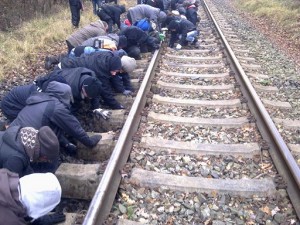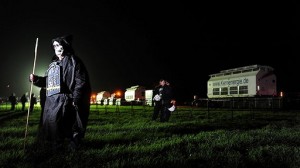(From the Nuclear Resister #164, December 5, 2011. For a free copy of the current issue, email your postal address to nukeresister@igc.org.)

Castor Schottern activists in Germany work together to stop the train carrying nuclear waste by removing gravel ballast from under the rails. (Castor Schottern photo)
The 12th and last of the scheduled rail shipments of German nuclear reactor waste from a reprocessing center in France left the station a day earlier than expected in November. Authorities wanted to get the jump on tens of thousands of nuclear resisters assembling all along the possible routes from La Hague to the geologic grave site at Gorleben, in Germany’s northern Wendland. Despite the head start, this shipment took longer than any other to reach its destination due to the largest such opposition protest ever mounted in France, and the second largest in 35 years of nuclear waste protest in Germany. France’s failure to get German agreement to the expedited shipment also added to a delay at their border.
An echo of the past and inspiration for the present resistance to the shipments came from a prison in Frankfurt, where Franziska Wittig began serving an 80-day sentence October 14 for conviction of assault. She and two others had chained themselves to the tracks in November 2008, stopping the train at the French border for 12 hours. Wittig refused to pay an €800 fine.
Eleven massive Castor canisters on special rail cars made up the train that pulled out of Valognes, France, late on the afternoon of November 23. Already that morning, police using teargas and truncheons had cleared demonstrators from many places along the tracks, and during the day had faced down about 400 people moving through the countryside towards the railroad. While the protest camp just south of Valognes was being kept under pressure, the train proceeded haltingly through the evening as people were cleared from the tracks and damaged rail bed was repaired.
By that night, the train was headed through Amiens to Reims, and police had arrested at least 16 people and sent a few to the hospital. All those detained or arrested were released on the same day, and at least five are being prosecuted: two for trespassing on the tracks, two for a pair of small axes found in their van when stopped and searched, and an elderly woman being prosecuted for collecting four drinks from a torched police catering van. Trials are set for January 31 and February 7, 2012. Criminal damage inquiries into sabotage along the tracks and the actual arson of the catering van may lead to further prosecutions.
Meanwhile, in Germany, thousands of people and hundreds of tractors and other farm implements were converging along the possible rail routes, particularly the last 25 miles between Lüneburg and Dannenberg. As the shipment left Valognes, that section was closed to passenger rail service, and Radio Free Wendland went on the air, broadcasting updates from the tracks and helping coordinate local support and resistance. A large variety of direct actions and blockades, public as well as unannounced activities, would unfold over the next few days in the region well known for its broad support of the Castor protests.
The next morning, the train was stopped in Rémilly, and there it remained until Germany was expecting it. Police massed on both sides of the French-German border as protesters speculated about which route would be taken. In the Wendland, after an evening rally in Metzingen, more than a thousand demonstrators moved past police onto the main road between Lüneburg and Dannenberg, blocking traffic. Police responded with chemical sprays and water cannon to retake the road, injuring 20.
The train crossed the border Friday morning and was briefly stopped in Neunkirchen for protesters to be cleared from the track. In the Wendland, arson of police vehicles and railway hardware was reported, and police searched vehicles traveling the area. That night, journalists were kept out and police again brought water cannons into Metzingen, injuring 18 and arresting four overnight. Nearby, neo-nazis attacked and destroyed an information point vigil at Dumstorf.
Meanwhile, the train moved slowly north through the country as police cleared one group of blockaders after another, arresting dozens. Near Fulda, four women climbers suspended themselves over the tracks but the train kept running, and they were arrested. Cécile Lecomte, activist and former French climbing champion, was held for several days.
On Saturday afternoon, more than 20,000 people were rallying in Dannenberg, where the Castors would be transferred to trucks for the final leg of their journey to the Gorleben depository. Along the tracks from Lüneburg, it was estimated at least 3,000 were involved in various actions, including 800 committed to removing ballast stones from the railbed. Roads were blocked to inhibit police movement.
Through the evening and overnight, the nuclear waste shipment was halted while small groups locked on under the rails to block the tracks in several places, and at least 2,000 had taken up squatting along stretches of the Lüneburg to Dannenberg line. Police used force to clear those who would not leave the tracks when ordered, but could not keep up with the pace of actions.
By midday Sunday, four people secured by an innovative pyramid-shaped lock-down device on the tracks at Hitzacker, ballast stones removed by hand from a 20-meter stretch of track, and hundreds still on the tracks at multiple points had kept the train en route for over 92 hours, and it would soon be the most-delayed of all the Castor shipments. Hundreds more demonstrators began assembling in Gorleben, to block the road into the waste repository.
That night, police at Platenlaase arrested a farmer and confiscated five tractors, which were then used in the attempt to clear roadblocks created by the resisters. Fourteen hours after the pyramid lock-down, police admitted defeat at removing the activists. After negotiations, the activists removed themselves and the train proceeded very slowly as police cleared hundreds more squatting on the tracks. By 4:30 a.m. Monday, November 28, the train had arrived at Dannenberg.
While the Castors were loaded onto trucks Monday, more than 2,000 people were joining the road blockades along two possible truck routes, and police massed to remove them. When the trucks began moving Monday night, police, some on horseback, used increasing levels of force plus new water cannons to finally clear the road. Still, two activists managed to jump into the cab of the first of the trucks and delayed the convoy. In the end, the waste was delivered to the Gorleben dump after a 126 hour journey.
Health professionals reported by Monday night treating at least 355 people injured by police, including serious head wounds and a suspected back fracture from truncheoning.
The German anti-nuclear movement demonstrated its resolve to shut down the nuclear enterprise itself, even if the government should reverse its present policy to move away from nuclear power. In France, activists report a new, post-Fukushima momentum against the nuclear enterprise, even among residents of the North Cotentin peninsula where the nuclear fuel reprocessing plant is but one of several major nuclear installations long accepted by the locals.
For more information visit www.greenkids.de/europas-atomerbe.
Letters of support should be sent to Franziska Wittig, JVA Frankfurt III, Upper Kreuzäckerstr. 4, 60435 Frankfurt, Germany.
